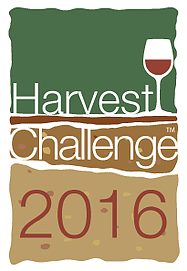 Congratulations to the winners of the Harvest Challenge 2016! Below are quick links to view the outcomes:
Congratulations to the winners of the Harvest Challenge 2016! Below are quick links to view the outcomes:
Cheers! Christopher
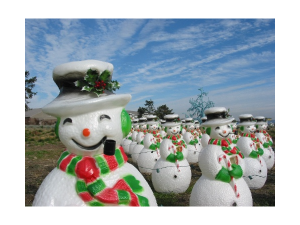 Precipitation or not, it is that time of year when the snowmen arrive in Sonoma! This Saturday December 3rd at 4pm the Festival begins at Cornerstone including many family friendly activities:
Precipitation or not, it is that time of year when the snowmen arrive in Sonoma! This Saturday December 3rd at 4pm the Festival begins at Cornerstone including many family friendly activities:
-Holiday decorations, lights + music
-Kids activities including face painting and felt ornament making
-Jolly Old Saint Nick handing out candy canes
-S’more Making with Sunset Magazine
-The Fig Rig
-Hot soups
-Beer, wine + champagne
-Sweet Scoops Ice Cream Cart
-Hot coffee and hot chocolate
-KZST Radio broadcasting live from Cornerstone
Bundle up and join in the wintery fun!
As is the case with any family-owned business, collaborative efforts between older and younger generations can have a huge impact on the success or failure of the brand over time.
As proprietors of the oldest continuously operating family-owned winery in America, a major turning point for the Wente family happened in 1912 when aspiring second generation winegrower Ernest Wente persuaded his father, the winery patriarch Carl H. Wente, to import cuttings of the Chardonnay from the nursery at the University of Montpellier in France.
At the time, the main white grapes planted by the Wentes and other vineyard owners in the rising wine region of Livermore Valley were Semillon and Sauvignon Blanc. After getting permission from his father and help from Leon Bonnett of University of California at Davis, Ernest planted the budwood and other cuttings sourced from the nearby Giersburger Winery in Pleasanton.
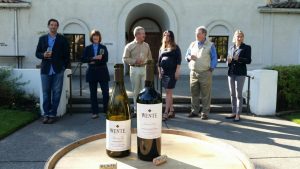
After forty years of experimentation, the two sources formed the basis of what is now called the Wente Clone of Chardonnay. With the continued success of the clone and fanfare from the media, the plantings of Chardonnay in California increased from 2,700 acres in 1970 to 45,000 acres in 1988. Today, there are almost 100,000 acres of the varietal planted in the state—nearly 80 percent of which is either Wente Clone 4 or special variations of its genetic cousins, including clones 5, 17, 72, 97 and the Hyde-Wente selection.
During that period, Ernest and his brother Herman would go on to establish a reputation as one of the top producers of fine wines in America—including the family’s release of a series of the nation’s first labeled bottles of Chardonnay, Sauvignon Blanc and Semillon in 1933, long before the term “fighting varietals” became en vogue.
In addition to the original 47 acres purchased by CH Wente in 1883, the family began developing new vineyards on special sites they purchased in Livermore Valley, including the Beyer Ranch, Hayes Ranch and the historic Cresta Blanca property, where the first winery in the valley was founded by Charles Wetmore in 1882. And following the advice of professors at UC Davis, the family was also among the first to invest in cool-climate properties in the cool-climate growing areas that would later become the Arroyo Seco and Monterey appellation of the Central Coast.
Today, the journey continues for the fourth and fifth generations of the family led by siblings Carolyn, Philip and Eric Wente, who took over operations in 1977.
As the first female CEO of the company, Carolyn has gone on to lead the charge of the expansion and growth of the Wente Family Estate portfolio, which now includes the premium brands Wente Vineyards, Murrieta’s Well, Double Decker, Hayes Ranch, and Entwine (a joint project done in association with Food Network). For wine culture, she also played a major role in establishing the Livermore Valley wine country lifestyle by launching Visitors Center and The Restaurant at Wente Vineyards in 1986 and The Concert, an annual series that attracts top music performers to the valley.
After graduating from UC Davis in 1975, Carolyn’s brother Philip took over the role as head of operations for the expansion and redevelopment of the Wente family properties. A few years later, he collaborated with Concannon Vineyards and other local winegrowers to make Livermore Valley an appellation in 1982. And in 1990, Philip teamed up with South American winemaker Sergio Traverso to purchase and preserve the historic Murrieta’s Well Estate Vineyard and Winery, where the original cuttings from Chateau d’Yquem and Chateau Margaux were planted in the 1880s.
As new estate vineyards came online in the 1980s, Philip and Carolyn’s brother Eric led the global expansion of Wente Family Estate brands, which are now represented in 70 countries around the world. As current Chairman of the Board of Directors for WFE, Eric currently oversees the family’s operations which includes 3,000 acres of vineyards, a Greg Norman-designed championship golf course, an award-winning restaurant, and a sustainably-certified cattle ranch.
In addition to providing guidance and financial support for the Livermore Valley and Arroyo Seco wine commissions, Carolyn, Philip and Eric have each served as president of the California Wine Institute, the largest political policy and wine advocacy organization in the state, which their family helped start more than 80 years ago.
While building exciting new estate brands and preserve the legacy of the family; the strategic decisions, innovations and accomplishments made by these three siblings has opened the doors for new possibilities created by the fifth generation as well.
Embracing the Small Lot concept
Today, the leader of this next generation is Eric and his wife Arel’s son, Karl Wente. Although he worked summers at Wente Vineyards when he was young, Karl’s real journey to becoming the winemaker didn’t start until he enrolled in the Viticulture and Enology programs at UC Davis, after completing his degree in Chemical Engineering at Stanford University.
It was during this informative period that Karl teamed up and his uncle Philip on a unique project focused on exploring the old heritage blocks of Chardonnay and Pinot Noir that were that were planted at the estate by the generations before them. In following the classic techniques used by their forefathers, they sampled grapes from the individual vines and tagged the plants with distinctive flavors that set them apart from the rest.
The experience provided Karl with a more personalized perspective on how his family’s heritage clones and other special selections planted on estate properties influence the flavor profiles of the finished wines from vine to the bottle.
“That experience reinforced the simple truth that humans like to chase flavors that are the most yummy,” says Karl in his exclusive interview with The Tasting Panel. “They are moments I will never forget.”
As a result, the budwood from the selected vines was used to develop an exciting new series of estate vineyards. While these young plantings progressed, Karl received his Master degree from UC Davis and spent the following year fine-tuning his winemaker skills, working harvests at Peter Michael Winery in Sonoma County and Brown Brothers in northern Victoria, Australia. After returning back to the Wente Estate in Livermore, he started an innovative series of Small Lot and Nth Degree programs in 2002.
Today, the Wente wine program is firing on all cylinders. In comparison to the larger production wines sold under the Wente Vineyards label, the Small Lot and Nth Degree wines are made on a more boutique scale of 3,000 cases each. For this reason, the fruit for each program is carefully selected by Karl and Philip.
According to Philip, the ultimate goal of the Small Lot program is to create site-driven wines that are expressive, thought-provoking and unique. “Owning our estate means we have the ability to go out and play with the vines in order to take grape quality to a higher level of uniformity, so you are literarily able to touch every cluster before it’s harvested. By doing this in small quantities of 200-300 cases, if the experiential block doesn’t turn out the way you wanted it, you haven’t sacrificed that much.”
From the point of a winemaker, Karl concurs. “My goal is to make each wine separately to showcase its own level of elegance, intensity, and ultimately let the vineyard speak to you,” he says. “As the name of the Nth Degree implies, as a winemaker my job is never done. To me that’s the beauty of growing grapes and making wine. Every vintage is different. And Mother Nature always has the last laugh, so you have to stay on your toes.”
In the Vineyards
To make this happen, the newer vineyards are designed with more attention to detail. In addition to matching the soil, climate conditions and rootstocks with the appropriate varieties and clones; other important changes have included the use of more innovative trellis systems and row orientations, closer vine spacing, sap flow sensors and improved drip irrigation systems, and aerial images to monitor the vines in each individual block.
Over time, these changes have not only improved the health of the vines and the quality of fruit, but also allowed the family to triple or quadruple the vine count per acre.
To preserve and protect the estate properties, the Wentes began developing their own “Farming for the Future” program in the early 1990s. This integrated system of sustainable farming practices is centered around enhancing the vitality of the soils by creating more biodiversity in the vineyards with the use of compost, cover crops, beneficial bugs, bird boxes, as well as innovative recycling techniques, energy and water conservation practices, and other eco-friendly applications to help maintain a harmonious balance between the family’s properties, vineyards, and estate wineries. This foreword thinking approach earned the Wente Family Estates one of the first Certified California Sustainable designations in 2010.
“In making these changes, we basically transformed the whole viticultural system,” says Eric Wente. “After that, the key has been learning how to execute on a yearly basis as the vineyards mature.”
In the cellar
Like the generations before him, Karl does not rest on his laurels in the cellar.
In general, Chardonnay clusters from Arroyo Seco spend an extra month on the vines in comparison to the ones grown around Livermore. This factor, combined with the deep, rich soils in the region made famous by world-class produce and Steinbeck novels, results in more intensive tropical fruits flavors than the slightly leaner and more minerally expressions from the Chardonnays made with fruit from Livermore Valley.
The isolation of these special flavors is based on picking date, lees contact and the use of special oak barrels that complement the signature styles that set the annual releases of the Riva Ranch, Mountain Dew, Nth Degree and Eric’s Small Lot Chardonnays apart from all the rest.
Another inspiring white wine is the Louis Mel Sauvignon Blanc, which is named after the legendary winemaker who brought in the original cuttings of the varietal to Livermore Valley from Chateau d’Yquem.
“With Sauvignon Blanc, my point of view is the raw flavors of a small oyster from British Columbia on the halfshell and the intangible burst of mineral and bright acidity that dazzles the palate,” says Karl, who now lives in the house on the Murrieta’s Well property that Mel built in the 1880s.
Granted, this style was not easy to perfect—as proven by Karl’s inaugural vintage in 2002, which he admits was too ripe. Since then, he’s started to pick earlier and the difference shows.
“What I’ve found is that if Sauvignon Blanc tastes perfect on the vine, then you’ve missed the mark by a week,” says Karl. “And although the flavors don’t present themselves right away, they will later express themselves in the glass.”
On Red Winemaking
This focus on perfection carries over to the red wine programs as well.
For starters, Karl has a sign hanging on his wall that reads “Love the wine you’re with.” So in addition to working with classic varietals like Cabernet Sauvignon, Merlot, Cabernet Franc, Petite Sirah and Syrah that thrive in the warm climate conditions of Livermore Valley and Pinot Noir grapes grown in cooler-climate area of Arroyo Seco, Karl and Philip have also been experimenting with newer plantings of Malbec, Graciano, Tempranillo, Barbara, Counoise, Grenache and other intriguing red varieties.
“Inevitably, I’m going to touch and fall in love with working with all of these special grapes along with way,” says Karl, with a chuckle.
To increase the level of quality of the fruit, the red grapes are now harvested at night in small increments of a ton or half-ton and sorted on tables before entering the winery. To maximize flavors of each batch, the berries are fermented in small insulated punch-down tanks that allow Karl and his team to easily control the process.
“Realistically, you only have ten days from the time you pick the grapes until you are able to hit the target of color, intensity, stability, the right tannins and mouthfeel,” says Karl. “On top of that, you only get one chance per year. So every decision matters.”
In addition to working with the Small Lot artisan wine series, Karl oversees the production of the larger volume Wente wines that also represent expressions from the estate. For that reason, he’s always happy to receive feedback when he’s out on the road or simply hanging out with customers who are participating at the festive tasting events, concerts, The Winemakers Studio, or culinary experiences hosted at the Wente properties in Livermore.
“To me, feedback is so important. For that reason, I love tasting with anybody that has a point of view. I’ve got thick skin and I know that everyone doesn’t have to love everything. But at the end of the day, a great wine teaches us all lessons.”
Team buliding
Of course, Karl doesn’t do it all this by himself. For the bigger wine projects, his go-to man is Brad Buehler, who has been making wine with Wente family for over 30 years. There are also young rising stars like Andy Ridge and Elizabeth Kester, who were recently promoted to winemakers for Wente Vineyards, and veteran winemaker Robbie Meyers, who Karl first met when he interned at Peter Michaels in Knights Valley, is the head winemaker at Murrieta’s Well.
Karl’s sister Christine is a spokesperson for the company and President of the Wente Foundation for Arts Education, a non-profit organization committed to raising money to support art education programs in Livermore and around the United States. And Philip and Carolyn’s children also work in the wine industry with exciting projects with Constellation Brands, Huneeus Vintners, and Spain wines. And in addition to the production of wine, the Wentes have also earned a reputation for finding the right people to hire for hospitality, sales and marketing, and administrative positions that stay on for the long-haul.
According to Carolyn, it comes down to hard core values. “We work very hard and follow through on what we say we’re going to do. We’re there to help people and respect others. It’s about integrity, sustainability and excellence. Like our parents did, it’s our responsibility to be innovative, building great teams, instilling confidence in our workers, and ultimately create and deliver world-class wines that make Livermore Valley a true wine country destination.”
Last year the Presidential Turkey served at the White House was the Nicholas White Turkey, a distinctive fluffy white breed with a bright red head that was developed in Sonoma Valley by George Nicholas at the Nicholas Turkey Breeding Farms in the 1950s.

For that occasion, I was honored to be asked to do a special set of Sonoma-based wine pairings with this culinary gem for President Barack Obama and his family, in association with the National Turkey Federation and Foster Farms, which raised this one-of-a-kind bird for the White House to celebrate the company’s 75th anniversary.
As is the case with all holiday gatherings, the golden rule for pairings is to choose wines that complement the flavors of the turkey and other tasty dishes being served, instead of overwhelming them.
This year, published in the Valley of the Moon Magazine, are my Holiday Picks for 2016.
May all these wines bring you joy and holiday comfort!
Gloria Ferrer 2013 Blanc de Blancs Brut, Carneros:
Start the festivities off in style with this elegant chardonnay-based sparkling wine with alluring aromas and dazzling flavors of ripe pear, crisp apple, Meyer lemon, roasted nuts, baking spices, and a creamy texture that works wonders with fresh oysters, appetizers, starting courses, and saltier dishes served with turkey. $47
Gundlach Bundschu 2015 Dry Gewurztraminer, Sonoma Coast:
From the oldest family-owned winery in California, this classic Thanksgiving wine features tangy flavors of fresh melon, peach, grapefruit, white pepper, nutmeg and a crisp dry finish. Beyond the turkey, the perky acidity of this wine pairs extremely well with soups, salads, yams and sweet potatoes as well. $25
Westwood 2014 Estate Pinot Noir, Annadel Gap Vineyard, Sonoma County:
Crafted with pristine fruit grown on the northern edge of Sonoma Valley, this expressive new pinot noir is layered with elegant notes of ripe berries, cherry cola, vanilla, cinnamon, and silky texture. Try this pinot noir with fine cheeses, cranberries, wild mushrooms and all the fixings on the dinner table or delicious sandwiches the day after. $44
Ravenswood 2013 Red Blend, Pickberry Vineyards, Sonoma Mountain:
Celebrating their 40-year anniversary, winemaker emeritus Joel Peterson and the team at Ravenswood Winery have earned an international reputation as elite producers of zinfandel-based wines. But at the winery on Gericke Road in Sonoma, you can try other special releases, like the Pickberry Vineyards Red Blend, an intermingling of merlot and cabernet sauvignon, highlighted by generous flavors of ripe berries, dark plum, currants, wild herbs, and layers of spice. Rich, smooth and supple, the texture of this wine is a great complement to grilled vegetables, turkey, ham, and richer dishes served during the holidays. $50
Little Vineyards 2013 Syrah, Estate Grown, Sonoma Valley:
Syrah can provide that touch of spice to each course served during the holidays. A Gold winner at the Sonoma County Harvest Fair
in September, the Little Vineyards 2013 syrah features deep and rich notes of boysenberry, blackberry, lavender, licorice, vanilla, allspice, toasty oak and a persistent finish. Try this nicely balanced wine with tangy sauces, fresh herbs and savory dishes served with the turkey or red meats. $38
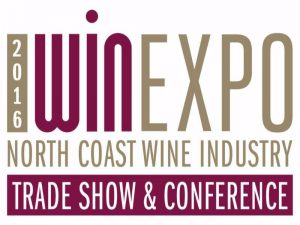 The 5th Annual North Coast Wine Industry Expo (@WINexpo) is coming up! It has quickly become an integral event for the North Coast wine industry bringing Sonoma, Napa, Lake & Mendocino Counties together for an all-inclusive Trade Show & Conference experience.
The 5th Annual North Coast Wine Industry Expo (@WINexpo) is coming up! It has quickly become an integral event for the North Coast wine industry bringing Sonoma, Napa, Lake & Mendocino Counties together for an all-inclusive Trade Show & Conference experience.
Seminars Include:
As the sixth largest economy in the world, it is safe to assume California residents are already going local. This vintage article in the New York Times Eat Local; Drink European reminded us of how far we have come in doing just that, supporting the amazing assortment wineries in of our great state.
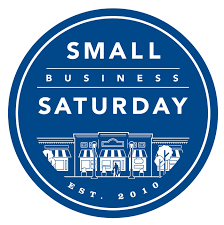 While this isn’t possible everywhere in the nation there are alternatives to wine when the aim is to support the local community. Maybe a side dish at Thanksgiving? Holiday shopping on Small Business Saturday? Dishing out Christmas dinner at the local shelter? Whatever you can contribute not only strengthens the local economy, but can give a well deserved warm fuzzy to liven up your personal celebrations!
While this isn’t possible everywhere in the nation there are alternatives to wine when the aim is to support the local community. Maybe a side dish at Thanksgiving? Holiday shopping on Small Business Saturday? Dishing out Christmas dinner at the local shelter? Whatever you can contribute not only strengthens the local economy, but can give a well deserved warm fuzzy to liven up your personal celebrations!
Cheers & Happy Holidays from the Sawyer Family!
Special announcement! If you are considering the Napa Valley Film Festival this week then maybe I can entice you to join me: I will be moderating the Culinary Demos throughout the week, as well as attending Variety’s 10 to Taste. Get your tickets ASAP!

The final tally is upon us. Just a reminder if you have not already mailed or dropped off your ballot that Tuesday November 8th is the final day cast your vote! Your voice matters.
After you participate in the general election, use that momentum to participate in the Bohemian Best of Sonoma 2017! Please consider voting for me as Best Sommelier for Sonoma County?
Just type in Christopher Sawyer!
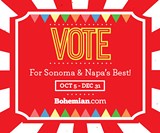 Many thanks for your support!
Many thanks for your support!
 Why enter your wines? Because the Harvest Challenge 2016 is a wine competition that bases its judging on a group of vineyards (or even vines) from the same region, belonging to a specific appellation, and sharing the same type of soil, weather conditions, grapes and wine making savoir-faire, which contribute to give the specific personality to the wine.
Why enter your wines? Because the Harvest Challenge 2016 is a wine competition that bases its judging on a group of vineyards (or even vines) from the same region, belonging to a specific appellation, and sharing the same type of soil, weather conditions, grapes and wine making savoir-faire, which contribute to give the specific personality to the wine.
In other competitions, this factor is ignored. At the Harvest Challenge, judges taste wines with other wines of the same appellation. Thus, with cross-regional competition removed, the inherent quality of wines can be seen without the influences that sometimes eclipse even a wine of very high quality.
Convinced yet? Follow this LINK to enter the competition!
I hope to taste your wines there!
Cheers, Christopher